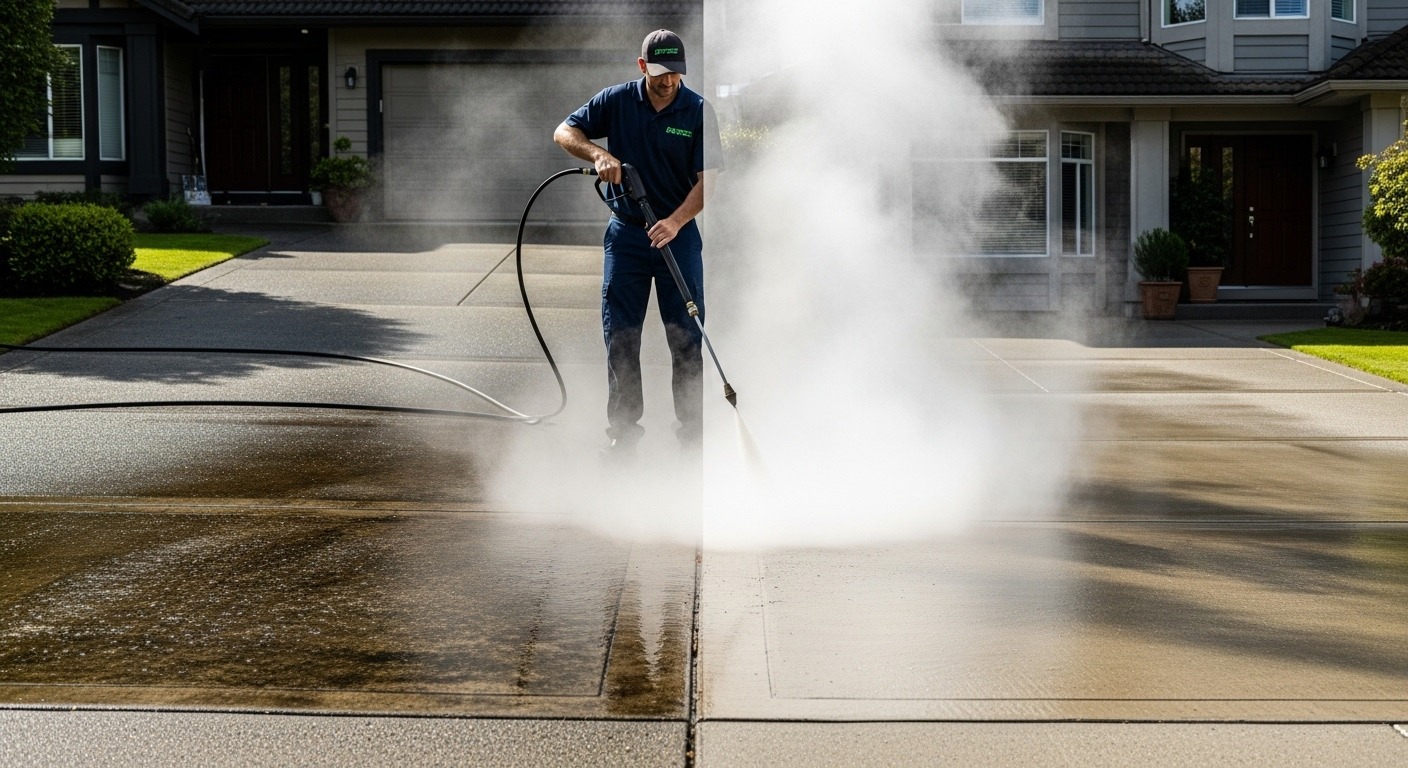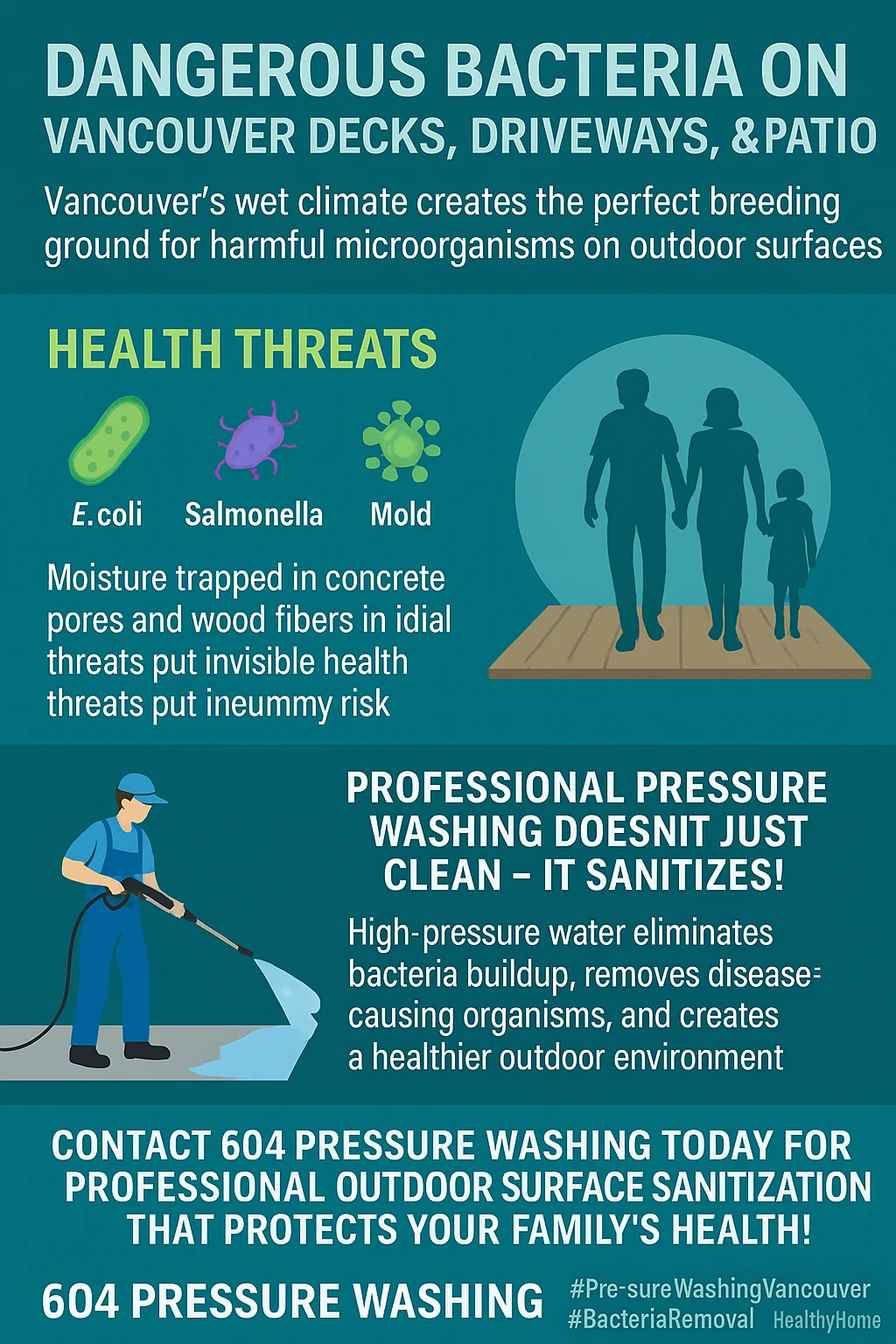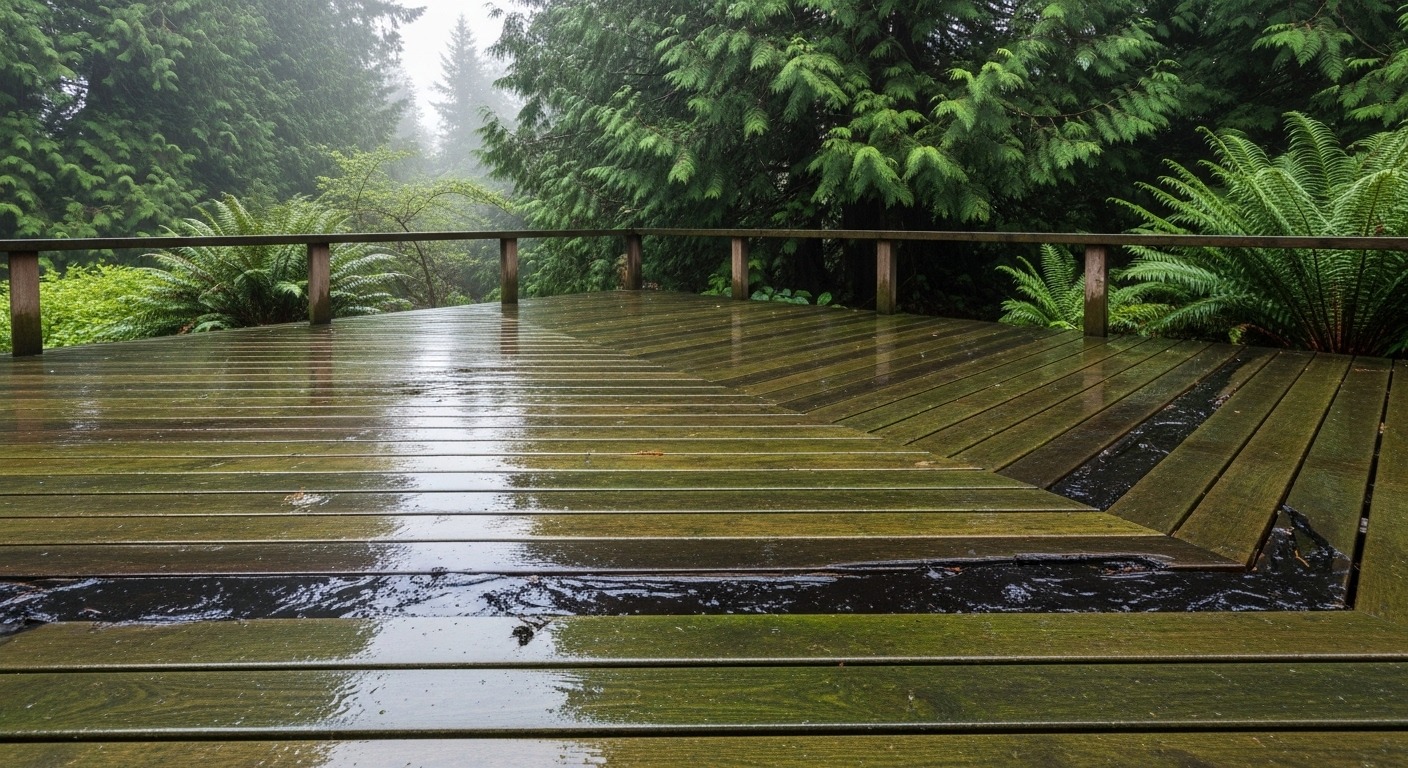Tired of unknowingly putting your family at risk from dangerous bacteria lurking on your outdoor surfaces? Vancouver’s unique climate creates the perfect breeding ground for harmful pathogens that no amount of regular cleaning can eliminate, but professional pressure washing offers a scientifically-proven solution that protects your loved ones while creating genuinely healthier outdoor living spaces. Imagine stepping out onto your deck for a morning coffee, only to discover that the seemingly clean surface beneath your bare feet harbors thousands of dangerous bacteria including E. coli, Staphylococcus, and even antibiotic-resistant MRSA strains that could seriously compromise your family’s health. This scenario isn’t just possible in Vancouver—it’s virtually guaranteed due to our city’s distinctive coastal climate that creates optimal conditions for bacterial proliferation on outdoor surfaces throughout the year. Most homeowners remain completely unaware that their driveways, patios, decks, and walkways serve as breeding grounds for pathogenic microorganisms that pose legitimate health risks to children, elderly family members, and anyone with compromised immune systems.  The combination of Vancouver’s persistent rainfall, mild temperatures, and high humidity creates what microbiologists describe as a “perfect storm” for bacterial growth, with conditions that allow dangerous pathogens to not only survive but actively reproduce on common outdoor surfaces. Recent scientific research reveals that concrete surfaces, wooden decks, and other outdoor materials consistently harbor bacterial populations that exceed contamination levels found on toilet seats by more than 1000 times, yet most families interact with these surfaces daily without any awareness of the hidden health risks. Understanding how professional pressure washing creates genuinely healthier living environments requires examining the science behind bacterial contamination, the specific environmental factors that make Vancouver particularly challenging, and the proven mechanisms through which high-temperature pressure washing eliminates these invisible threats to family wellbeing. Professional pressure washing represents far more than an aesthetic improvement service—it’s a critical health intervention that employs thermal pasteurization, mechanical removal, and specialized chemical sanitization to eliminate bacterial populations that conventional cleaning methods simply cannot reach. The difference between consumer-grade cleaning approaches and professional bacterial elimination extends beyond equipment quality to encompass the fundamental science of pathogen destruction, with commercial hot water systems achieving temperatures between 185°F and 311°F that reliably eliminate dangerous bacteria while protecting surface integrity through precise pressure and temperature control.
The combination of Vancouver’s persistent rainfall, mild temperatures, and high humidity creates what microbiologists describe as a “perfect storm” for bacterial growth, with conditions that allow dangerous pathogens to not only survive but actively reproduce on common outdoor surfaces. Recent scientific research reveals that concrete surfaces, wooden decks, and other outdoor materials consistently harbor bacterial populations that exceed contamination levels found on toilet seats by more than 1000 times, yet most families interact with these surfaces daily without any awareness of the hidden health risks. Understanding how professional pressure washing creates genuinely healthier living environments requires examining the science behind bacterial contamination, the specific environmental factors that make Vancouver particularly challenging, and the proven mechanisms through which high-temperature pressure washing eliminates these invisible threats to family wellbeing. Professional pressure washing represents far more than an aesthetic improvement service—it’s a critical health intervention that employs thermal pasteurization, mechanical removal, and specialized chemical sanitization to eliminate bacterial populations that conventional cleaning methods simply cannot reach. The difference between consumer-grade cleaning approaches and professional bacterial elimination extends beyond equipment quality to encompass the fundamental science of pathogen destruction, with commercial hot water systems achieving temperatures between 185°F and 311°F that reliably eliminate dangerous bacteria while protecting surface integrity through precise pressure and temperature control.
Key Takeaways:
- Vancouver’s coastal climate with over 1,100mm annual rainfall creates optimal conditions for dangerous bacterial growth on outdoor surfaces including E. coli, Staphylococcus, and antibiotic-resistant MRSA strains
- Scientific research confirms that outdoor surfaces consistently harbor bacterial concentrations exceeding those found on toilet seats by more than 1000 times, posing serious health risks through direct contact and airborne transmission
- Professional hot water pressure washing operating at 185°F to 311°F provides reliable bacterial elimination through thermal pasteurization, mechanical removal, and specialized chemical sanitization that DIY methods cannot achieve
- Children and elderly family members face elevated health risks from bacterial contamination, with potential complications including respiratory problems, skin infections, and immune system disorders that can require expensive medical treatment
- Regular professional pressure washing provides measurable economic benefits through healthcare cost avoidance, property value protection, and maintenance savings that exceed service costs while delivering comprehensive family health protection

The Hidden Bacterial Threat on Vancouver Outdoor Surfaces
The invisible bacterial contamination covering outdoor surfaces throughout Vancouver represents one of the most overlooked health hazards affecting families in our region, with scientific evidence revealing contamination levels that would shock most homeowners if they could see the microscopic reality of their seemingly clean patios and driveways. Research examining bacterial communities on concrete surfaces demonstrates that these common building materials host diverse microbial populations adapted to survive in the alkaline, often harsh conditions found on residential properties, with approximately 50 to 60 percent of observed bacteria originating from construction materials and persisting throughout the surface’s entire lifespan.  Laboratory studies specifically examining E. coli survival on cement-based surfaces provide particularly concerning insights for Vancouver homeowners who regularly interact with contaminated outdoor areas. While E. coli populations decrease significantly within four hours of surface contact, the bacteria remain detectable and potentially infectious for approximately 35 hours under optimal survival conditions, which Vancouver’s mild, moist climate consistently provides. This extended survival window means that bacterial contamination from a single source can pose ongoing health risks for more than a day, with higher temperatures accelerating bacterial decay while soil and organic matter extending survival times in ways that Vancouver’s abundant vegetation and moderate climate actively support. The scope of bacterial contamination on outdoor surfaces extends far beyond theoretical concerns, with playground equipment studies revealing that almost half of tested surfaces contained dangerous bacterial populations, including potentially lethal Staphylococcus strains resistant to conventional antibiotic treatments. These findings directly translate to residential outdoor surfaces where similar environmental conditions and usage patterns create comparable contamination risks for Vancouver families who utilize decks, patios, and walkways for daily activities. The presence of antibiotic-resistant bacterial strains on outdoor surfaces represents an escalating health threat that requires specialized elimination methods beyond what household cleaning products can provide. Vancouver’s specific environmental conditions create particularly favorable circumstances for bacterial growth and persistence compared to other Canadian cities with more extreme seasonal variations. The region’s temperate rainforest classification means bacterial growth conditions remain optimal year-round, unlike locations with harsh winters or extended dry seasons that naturally reduce pathogenic populations through environmental stress. Research conducted on Metro Vancouver beaches confirms that higher rainfall and elevated temperatures consistently predict increased E. coli concentrations, indicating that our typical weather patterns actively promote bacterial proliferation on all outdoor surfaces throughout the metropolitan area. The composite nature of common outdoor building materials means bacterial contamination begins during construction and continues throughout the material’s lifespan, creating persistent reservoirs of pathogenic microorganisms that accumulate over time rather than naturally declining. Concrete’s porous structure traps moisture and organic matter that support ongoing bacterial growth, while wood surfaces provide additional nutrients through natural decomposition processes that feed diverse microbial communities. Understanding this fundamental contamination reality helps explain why conventional cleaning methods fail to address bacterial populations and why professional intervention becomes necessary for reliable pathogen elimination.
Laboratory studies specifically examining E. coli survival on cement-based surfaces provide particularly concerning insights for Vancouver homeowners who regularly interact with contaminated outdoor areas. While E. coli populations decrease significantly within four hours of surface contact, the bacteria remain detectable and potentially infectious for approximately 35 hours under optimal survival conditions, which Vancouver’s mild, moist climate consistently provides. This extended survival window means that bacterial contamination from a single source can pose ongoing health risks for more than a day, with higher temperatures accelerating bacterial decay while soil and organic matter extending survival times in ways that Vancouver’s abundant vegetation and moderate climate actively support. The scope of bacterial contamination on outdoor surfaces extends far beyond theoretical concerns, with playground equipment studies revealing that almost half of tested surfaces contained dangerous bacterial populations, including potentially lethal Staphylococcus strains resistant to conventional antibiotic treatments. These findings directly translate to residential outdoor surfaces where similar environmental conditions and usage patterns create comparable contamination risks for Vancouver families who utilize decks, patios, and walkways for daily activities. The presence of antibiotic-resistant bacterial strains on outdoor surfaces represents an escalating health threat that requires specialized elimination methods beyond what household cleaning products can provide. Vancouver’s specific environmental conditions create particularly favorable circumstances for bacterial growth and persistence compared to other Canadian cities with more extreme seasonal variations. The region’s temperate rainforest classification means bacterial growth conditions remain optimal year-round, unlike locations with harsh winters or extended dry seasons that naturally reduce pathogenic populations through environmental stress. Research conducted on Metro Vancouver beaches confirms that higher rainfall and elevated temperatures consistently predict increased E. coli concentrations, indicating that our typical weather patterns actively promote bacterial proliferation on all outdoor surfaces throughout the metropolitan area. The composite nature of common outdoor building materials means bacterial contamination begins during construction and continues throughout the material’s lifespan, creating persistent reservoirs of pathogenic microorganisms that accumulate over time rather than naturally declining. Concrete’s porous structure traps moisture and organic matter that support ongoing bacterial growth, while wood surfaces provide additional nutrients through natural decomposition processes that feed diverse microbial communities. Understanding this fundamental contamination reality helps explain why conventional cleaning methods fail to address bacterial populations and why professional intervention becomes necessary for reliable pathogen elimination.
Vancouver’s Climate: The Perfect Bacterial Breeding Ground
Moving beyond the basic understanding of bacterial presence on outdoor surfaces, Vancouver’s distinctive coastal climate represents a nearly perfect environment for sustaining and amplifying pathogenic bacterial populations throughout the year. The city’s maritime influences combine with urban heat island effects and topographical variations to create microclimates that consistently provide the moisture, temperature stability, and nutrient availability that dangerous bacteria require for continuous reproduction and population growth.  Vancouver’s annual precipitation exceeding 1,100 millimeters ensures that outdoor surfaces remain consistently moist throughout most of the year, providing the water activity levels that bacterial metabolism and reproduction processes require. Unlike regions with distinct dry seasons that naturally desiccate and eliminate bacterial populations through environmental stress, Vancouver’s climate maintains hydration levels that support ongoing bacterial activity across multiple seasons. The city’s mild temperature ranges rarely reach extremes that would naturally pasteurize contaminated surfaces, allowing established bacterial colonies to persist and multiply without significant environmental pressure to reduce their populations. The interaction between Vancouver’s frequent rainfall events and elevated temperatures creates particularly dangerous conditions for pathogenic bacterial proliferation during spring and summer months. Heavy rainfall sends pollution-filled storm runoff into surface water systems, introducing additional contaminants that settle on residential properties and provide nutrients for bacterial growth. Higher humidity levels during warmer periods create ideal reproductive conditions, while the combination of organic matter decomposition and persistent moisture generates the complex nutrient profiles that support diverse bacterial communities including antibiotic-resistant strains. The Greater Vancouver area’s coastal location introduces unique bacterial contamination sources that inland communities do not experience, including marine-influenced weather systems that transport pathogenic microorganisms from oceanic sources and distribute them across residential areas through atmospheric deposition. Tidal influences in coastal regions affect bacterial distribution patterns, while freshwater inputs from mountain runoff dilute natural salinity levels that might otherwise inhibit some bacterial species. This combination creates optimal growth conditions for many pathogenic bacteria while providing continuous inputs of new contamination sources that replenish surface bacterial populations even after cleaning efforts. Vancouver’s extensive urban forest canopy, while providing numerous environmental benefits, contributes significantly to bacterial growth conditions through continuous organic matter deposition and enhanced moisture retention in shaded areas. The region’s abundant vegetation produces ongoing inputs of leaves, pollen, and organic debris that accumulate on outdoor surfaces and decompose to provide rich nutrient sources for bacterial communities. Shaded areas beneath trees and structures maintain elevated moisture levels for extended periods, creating protected microenvironments where bacterial populations can flourish even during relatively dry weather conditions. Seasonal bacterial growth patterns specific to Vancouver’s climate demonstrate why conventional cleaning approaches fail to provide adequate pathogen control throughout the year. Spring conditions combine increased temperatures with abundant moisture and decomposing organic matter to create bacterial growth explosions
Vancouver’s annual precipitation exceeding 1,100 millimeters ensures that outdoor surfaces remain consistently moist throughout most of the year, providing the water activity levels that bacterial metabolism and reproduction processes require. Unlike regions with distinct dry seasons that naturally desiccate and eliminate bacterial populations through environmental stress, Vancouver’s climate maintains hydration levels that support ongoing bacterial activity across multiple seasons. The city’s mild temperature ranges rarely reach extremes that would naturally pasteurize contaminated surfaces, allowing established bacterial colonies to persist and multiply without significant environmental pressure to reduce their populations. The interaction between Vancouver’s frequent rainfall events and elevated temperatures creates particularly dangerous conditions for pathogenic bacterial proliferation during spring and summer months. Heavy rainfall sends pollution-filled storm runoff into surface water systems, introducing additional contaminants that settle on residential properties and provide nutrients for bacterial growth. Higher humidity levels during warmer periods create ideal reproductive conditions, while the combination of organic matter decomposition and persistent moisture generates the complex nutrient profiles that support diverse bacterial communities including antibiotic-resistant strains. The Greater Vancouver area’s coastal location introduces unique bacterial contamination sources that inland communities do not experience, including marine-influenced weather systems that transport pathogenic microorganisms from oceanic sources and distribute them across residential areas through atmospheric deposition. Tidal influences in coastal regions affect bacterial distribution patterns, while freshwater inputs from mountain runoff dilute natural salinity levels that might otherwise inhibit some bacterial species. This combination creates optimal growth conditions for many pathogenic bacteria while providing continuous inputs of new contamination sources that replenish surface bacterial populations even after cleaning efforts. Vancouver’s extensive urban forest canopy, while providing numerous environmental benefits, contributes significantly to bacterial growth conditions through continuous organic matter deposition and enhanced moisture retention in shaded areas. The region’s abundant vegetation produces ongoing inputs of leaves, pollen, and organic debris that accumulate on outdoor surfaces and decompose to provide rich nutrient sources for bacterial communities. Shaded areas beneath trees and structures maintain elevated moisture levels for extended periods, creating protected microenvironments where bacterial populations can flourish even during relatively dry weather conditions. Seasonal bacterial growth patterns specific to Vancouver’s climate demonstrate why conventional cleaning approaches fail to provide adequate pathogen control throughout the year. Spring conditions combine increased temperatures with abundant moisture and decomposing organic matter to create bacterial growth explosions

